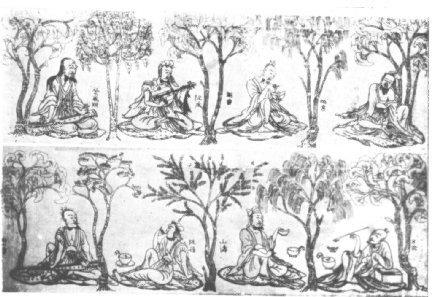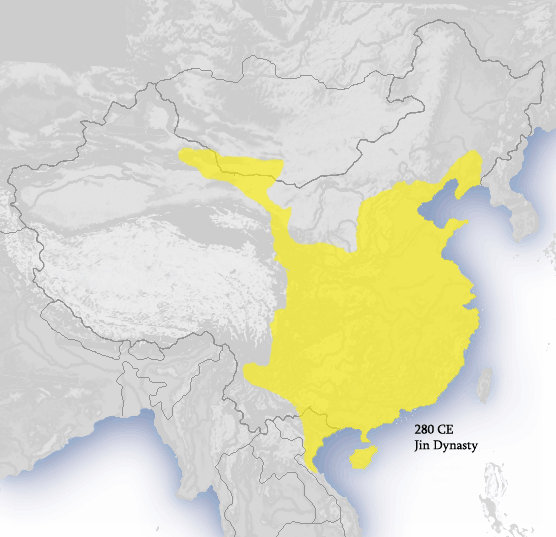The early Jin Dynasty enclosed two distinct periods, which are the Western and Eastern Jin. The Western Dynasty was founded by Emperor Wu in Luoyang, while the Eastern Dynasty was established by Sima Rui in Jiankang.
The Events Leading up to the Jin Dynasty
Before the establishment of the Jin Dynasty (265 – 420), Sima Yi was a Wei State minister during the Three Kingdoms Period. He was a talented military mediator throughout the wars in opposition to the Shu and Wu State. In 239, Emperor Mingdi of Wei State died and Cao Shuang and Sima Yi were appointed as co-heads of the state’s armed forces. On the outset, the two men took on a vicious power battle. At first, Cao seized the actual power, although Sima Yi would eventually reign. On one occasion, when the Wei Emperor and Cao voyaged to clear Mingdi’s last resting place, Sima Yi had taken over the compound of Cao Shuang, his armories and blocked right of the entry to Luoyang. He subsequently required the Empress to eradicate the official pose of Cao Shuang along with his brother. Cao quit because he saw no other choice. Soon after, on the other hand, Cao and a lot of of his contemporaries were put to death for sedition. This allowed Sima Yi to start his tyrannical rule of the Wei State.
Sima Zhao and Sima Shi
Following Sima Yi’s demise, his family’s armies in the Wei State were progressively merged by his sons Sima Zhao and Sima Shi. His sons did not agree most of the time and clashed in numerous fights against one another. Sima Zhao, in 263, came up with a set up to get the pose for himself. He instructed his men Deng Ai and Zhong Hui to assault the Shu State. As the armed forces of the Wei State protested on Shu’s central city, Chengdu, its King Liu Shan admitted defeat despondently. This successfully had driven the Shu State non-existent. Soon after, Zhong Hui made friends with Jiang Wei, a past general of Shu. They planned a rebellion, but were concealed by Sima Zhao. Afterward, Sima Zhao passed away and, in 265, his son Sima Yan seized the pose of the Wei State. This commemorated the founding of the Jin Dynasty. Sima Yan designated himself as Emperor Wu and he made Luoyang as his empire’s capital.
Sima Yan
Subsequently to rising to the pose, Sima Yan was equipped to bring together China for a brief phase of time, although he could not handle the ubiquitous social tribulations that disillusioned the political setting. Slowly, the condition worsened to the time where the grand court was in a full status of disorder. A number of factions started to compete for supremacy. The renowned Eight-King Rebellion was instigated by means of the eight kings Sima Yan had earlier appointed. This mix up for ruling supremacy on the Jin Dynasty had left the empire terribly destabilized. Itinerant tribes who lived in the north were relentlessly aggressive and seized the chance to set up their own rules.
Sima Rui and the Eastern Jin Dynasty

In 317, the imperial kin, what was left of the Jins, migrated to the south. Sima Rui declared himself ruler in Jiankang and reinstituted the Jin Dynasty. Tyrannical leaders and military predicaments beleaguered the Eastern Jin Empire during its 104 years’ of continuance. Revolts were common as diverse individuals made an attempt to take the throne. Throughout this period, Sima Rui passed away in distress and righteous anger. Emperor Gong was the final leader of the Eastern Jin dynasty and existed for merely a year subsequent to being ousted by General Liu Yu. This occurrence commemorated the conclusion of the Eastern Jin Dynasty and the start of the Southern Dynasties and Liu Song.
In accordance with the adage that those that have been unified for an extensive period of time should be separated and those that have been separated have to be unified, accord was ultimately reinstated in the formative years of the Jin Dynasty. At the conclusion of the Three Kingdoms era, Sima Yan, which was a famous family unit in the regime of the Wei Kingdom, took over power and founded a novel dynasty, which is the Jin Dynasty.
The eastern dynasty primarily subjugated the region south of the Yangtze River, whereas Northern China was taken up by other cultural groups. Throughout the time, from 304 to 439, many cultural groups established their own states in this vicinity. Geologically, located in the north were fifteen states and in the southwest area, the Kingdom of Chenghan, termed the Sixteen States. The Sixteen States battled against one another ceaselessly. The venerable wars and clashes ruined the financial system of the northern regions. Throughout this time, the mix of nations was hastened in the course of enduring agreements and joint interests.
Southern Migration and Northern Tribulations
In general, the South Chinese economy progressed more compared to that of North China during the Jin Dynasty. Because of the ceaseless fighting in North China, many people, particularly the meager, traveled to the south part of the Yangtze River in search of a more quiet life. The migration of large populations strengthened the workforce in southern parts and as well brought higher output systems and implements. Furthermore, several rivers in the part Yangtze River south presented first-rate irrigation prospects for agricultural fabrication. Every element endorsed the growth of agriculture in this region.
The Jin Dynasty and the subsequent Northern and Southern Dynasties were the only time throughout which the country was united, even though this united period lasted for merely around 150 years. Throughout the Jin Dynasty, the economy was as well rising and the center, Jiankang, turned out to be the principal business city south of the Yangtze River. Simultaneously, citizens from the north contributed to the improvement of the craft industry.
